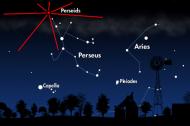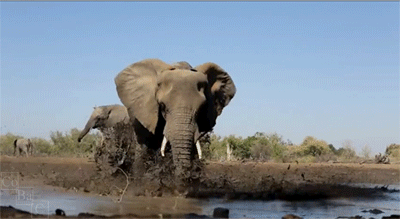
They’re intelligent. They’re family-oriented. They have great memories. They are capable of feeling a wide range of deep emotions, from intense grief to joy bordering on elation, as well as empathy and stunning self-awareness. They create complex, supportive societies much like our own. Taking into consideration all of that and much, much more, what’s not to love about elephants? Still, countless elephants are brutally killed every year for their ivory by greedy poachers who then leave their carcasses to rot in the sun. As Graydon Carter, Editor of Vanity Fair, put it:
We admire elephants in part because they demonstrate what we consider the finest human traits (…) but the way we treat them puts on display the very worst of human behavior.
World Elephant Day is the perfect time to find out more about these amazing animals and what we can do to preserve and protect them so they do not go the way of the mammoth.
World Elephant Day was created in 2011 by two Canadian filmmaker Patricia Sims and Thailand’s Elephant Reintroduction Foundation and was first celebrated on August 12, 2012. The initiative was greatly supported by film star William Shatner who narrated the documentary Return to the Forest, a fascinating 30-minute film about the reintroduction of captive Asian elephants to the wild. Currently, the demand for ivory is the biggest in China, with the price of ivory often exceeding the price of gold, something that makes elephants bigger targets than ever. Habitation loss is also a danger to the world’s elephant population as it deprives elephants of the hundreds of pounds of food they need every day, making it more difficult for them to breed and making it easier for poachers to track them down. Circuses and tourism are also serious threats to the animals’ well-being. Luckily, an increasing number of both celebrities and politicians have become interested in the cause, including Leonardo DiCaprio, Ashley Judd and President Barack Obama.
Word of the Day
| |||
| Definition: | (adjective) Impossible or difficult to perceive by the mind or senses. | ||
| Synonyms: | unperceivable | ||
| Usage: | The world may indeed be considered as a vast machine, in which the great wheels are originally set in motion by those which are very minute, and almost imperceptible to any but the strongest eyes. | ||
Idiom of the Day
a knife in the back— A grievous or supreme act of treachery or betrayal. (Usually preceding "of/for (someone). |
History
Isaac Singer Granted Patent for Sewing Machine (1851)
Before the advent of the sewing machine, sewing was a laborious task. Singer's 1851 sewing machine patent made him a very rich man. Several other people laid claim to having invented the sewing machine, notably Elias Howe, who won a lawsuit against Singer for infringement. Nevertheless, Singer's company was already well established and was able to pool its patents with other claimants to avoid litigation.
Ross and Norris McWhirter (1925)
In 1954, a few years after identical twins Norris and Ross McWhirter founded a London fact-finding agency, they met a director of the Guinness brewing company, Sir Hugh Beaver, who commissioned a compilation of world records that was intended to settle bar-room disputes. The first edition of the McWhirters' Guinness Book of Records was given to bars for free as a marketing gimmick, but the book quickly became a phenomenal success.
Hope Watermelon Festival
Best known as the birthplace of U.S. President Bill Clinton, Hope, Arkansas, is also "Home of the World's Largest Watermelons" and hosts the only watermelon festival featuring giant watermelons. They are indeed large. Hope watermelon growers have been competing to grow the biggest since the 1920s. This is a festival of real down-home Americana: ice cream socials, a big fish fry, softball, arts and crafts booths, musical entertainment, antique car shows and hot air balloon rides. The watermelon events include a melon-eating contest, a seed-spitting contest and a melon-judging and auction.
Coddled Puppies Make Poor Guide Dogs, Study Suggests
| Well-trained guide dogs are important for visually impaired people who rely on them. But many puppies bred to be guide dogs flunk out of training programs. |

Coddled Puppies Make Poor Guide Dogs, Study Suggests
1865 - Disinfectant was used for the first time during surgery by Joseph Lister.
1877 - Thomas Edison invented the phonograph and made the first sound recording.
1915 - "Of Human Bondage" by William Somerset Maugham was first published.
1937 - Red Skelton appeared on network radio for the first time on the "Rudy Vallee Show" on NBC.
1939 - "The Wizard of Oz" premiered in Oconomowoc, WI. Judy Garland became famous for the movie's song "Somewhere Over the Rainbow." The movie premiered in Hollywood on August 15th.
1960 - The balloon satellite Echo One was launched by the U.S. from Cape Canaveral, FL. It was the first communications satellite.
1964 - Mickey Mantle set a major league baseball record when he hit home runs from both the left and ride sides of the plate in the same game.
1972 - The Festival of Hope concert took place at Roosevelt Raceway in Long Island, NY. It was the first rock festival to raise funds for an established charity. The Nassau Society of Crippled Children and Adults was the sponsor.
1973 - Jack Nicklaus won his 14th major golf title. The win broke the record that had been held by Bobby Jones for 50 years.
1981 - IBM unveiled its first PC.
1986 - Rod Carew became the first player in the history of the California Angels franchise to have his uniform (#29) retired.
1998 - Swiss banks agreed to pay $1.25 billion as restitution to World War II Holocaust victims.


1.

Aug 12/13: Perseid Meteors
The shooting stars of the Perseid meteor shower, are known as the most active and brightest meteor showers of the year.
2.
INTERESTING FACTS
When he wasn’t contributing to the flexibility rights of clocks, Surrealist Salvador Dalí was contributing to the music industry in the form of album cover art. One cover happened to be an image for Honeymooners star Jackie Gleason’s Lonesome Echo LP, which featured a barren vista, save a butterfly speared on a stick.
The space between your pointer finger and thumb is called the "purlicue."
The toilet featured in Hitchcock's Psycho was the first flushing toilet to appear on-screen.
Nixon was speaking at Disney World when he famously declared, "I am not a crook."
Arthur Miller's original title for Death of a Salesman was The Inside of His Head.

Pictures of the day

Historic U.S. Route 66 outside Amboy, California. Established on November 11, 1926, it was one of the original highways within the U.S. Highway System. It served as a major path for those who migrated west, especially during the Dust Bowl of the 1930s, and was a part of 1960s popular culture.
Superseded by the combination of Interstates 40, 44, and 55, U.S. 66 was decommissioned in 1985; but various organizations have advocated the installation of "historic route" markers on surviving sections of the road, as seen here.
THE HIDDEN BUDDHA SURROUNDED BY A HILL OF 150,000 LAVENDERS
On the outskirts of Sapporo, Japan, you will find a sitting Buddha hidden under a hill of lavender
knit
thanks, Lisa

knit
thanks, Ivy

knit

knit
| Repeat Rows 1 - 8 |
| Row # | Side | Begin Row | Repeat | Repeat From * |
|---|---|---|---|---|
| 1 | R | p2* | (yo, ssk) twice, k2, k2-tog, yo, p2 | * |
| 2 | W | * | knit the knit stitches; purl the purl stitches; purl the yarn overs | * |
| 3 | R | p2* | k1, yo, ssk, k2, k2-tog, yo, k1, p2 | * |
| 4 | W | * | knit the knit stitches; purl the purl stitches; purl the yarn overs | * |
| 5 | R | p2* | yo, ssk, k2, (k2-tog, yo), p2 | * |
| 6 | W | * | knit the knit stitches; purl the purl stitches; purl the yarn overs | * |
| 7 | R | p2* | k1, yo, ssk, k2, k2-tog, yo, k1, p2 | * |
| 8 | W | * | knit the knit stitches; purl the purl stitches; purl the yarn overs | * |
crochet
thanks, Bertha
crochet
thanks, Nicki

crochet


crochet

RECIPE
thanks, Shelley

CROCKPOT RECIPE
thanks, Helen
SWEETS
thanks, Maria
ADULT COLORING
CRAFTS
Pin Cushion Mason Jar Craft
hometalk

CHILDREN'S CORNER ... easy snack
thank, Iris

PUZZLE
Statue Ochre Green Jigsaw Puzzle
WORD SEARCH
| adapt after basis blood brash business chant | destruction develop discussion dissolve enter field figure file force | guess heel main novel number option | pickle post preach redeem relate report rope score scout sins | sole space staff stereo store super tight zest |
SUDOKU ... very hard
solution:
QUOTE
CLEVER (180C is approximately 350 degrees, I believe)
EYE OPENER
THE NON-TOXIC WAY I KILLED ALL MY GRASS (ON PURPOSE!)
Supplies
- LARGE pieces of cardboard - check at mattress and appliance stores.
- Hose and spray nozzle or sprinkler
- Rocks or water filled jugs to help weigh everything down
Directions
Step 1: Cut the grass short
You can leave the clippings on top of the plot - no need to rake or bag it up. The goal is to get the grass short so the cardboard is less likely to "float" on top of tall tufts.
Step 2: Soak it
Get your hose and drench that sucker! Or turn on your sprinkler and walk away for a while. Make it very very wet.
Step 3: Lay the cardboard out on top
Get large pieces of cardboard and lay them out on top of the grass you want to kill. HUGE pieces do best. I had a few largeish boxes and they were too small. I'm talking ginormous - like boxes for mattresses or refrigerators. Be sure to overlap the edges so no sunlight in sneaking around the sides.
 |
| (this photo was actually taken after step 4 but I wanted you to see how there are NO GAPS!) |
Step 4: Soak and weigh down the cardboard
Get your hose or sprinkler back out and drench your cardboard. This will take a while the first time you do it and your sprinkler (if you have one) will be your best option.
Once your cardboard is absolutely drenched, weight it down in different spots by placing large rocks or empty milk or laundry jugs filled with water on top. This will help keep the corners from blowing up if the cardboard gets dried out.
Step 5: Water the cardboard occasionally
Be sure to pop over to your garden and water your cardboard every day or every other day if it isn't raining. Part of how this method works is by both smothering and blocking light from getting to the grass so keeping it damp and weighed down is critical.
Step 6: Clean it up
After about 3 weeks you can start to check your progress. Pick up a corner and peek underneath to see how the progress is coming along. I ended up leaving my cardboard on for a full month before removing it and it looked AWESOME!
I raked it lightly to get up any dead grass chunks. I also dumped used coffee grounds over the top to use as a mulch (just pop into your local Starbucks and ask for "grounds for your garden" and they will give you a whole trash bag full of used espresso grounds).



No comments:
Post a Comment